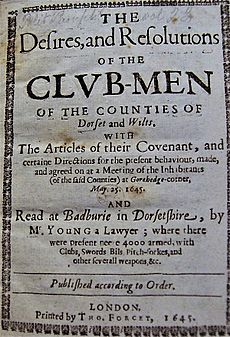Clubmen facts for kids
Clubmen were groups of local people who formed their own defence teams during the English Civil War (1642–1651). They wanted to protect their homes and families from the armies of both sides. They tried to avoid being forced to fight. They also wanted to stop their farms and belongings from being damaged or stolen. Soldiers, looters, and refugees often threatened their lives.
For a long time, people thought Clubmen mostly used simple tools as weapons. These included cudgels (heavy sticks), flails, scythes, and sickles tied to long poles. However, new research by Haydn Wheeler shows that some Clubmen also had horses and flags. Wheeler's book, Clubmen 1645, Neutralism in a Revolution, also looks at where the name "Clubmen" might have come from.
At first, Clubmen groups formed on their own when soldiers caused trouble nearby. But as the war went on, local leaders and churchmen helped organize them in some areas. This made the Clubmen a group that both armies had to consider. They were important, especially in the south and west of England. The Clubmen wore white ribbons to show they were different. They were not on the side of the Royalists or the Parliamentarians. Because of this, both sides treated them harshly. Even though Lord Fairfax met and talked with Clubmen, he eventually moved his army against them.
Woodbury Declaration
Organized Clubmen in Worcestershire held a meeting on Woodbury Hill on March 5, 1645. Their leader was Charles Nott, who was the parson (a type of priest) from Shelsley. At this meeting, they wrote the Woodbury Declaration. This document complained about the "utter ruin by the outrages and violence of the soldier." It also mentioned soldiers threatening to burn houses, attack women, and harm people. They gave this declaration to Henry Bromley, who was the Royalist Sheriff of Worcestershire.
How the Clubmen Were Stopped
The Clubmen of Dorset and Wiltshire were supposed to act as one big group. But in reality, they were divided. Clubmen from the Langport area clearly said they were separate from other groups in the region. This division led to different reactions when the Parliamentarian New Model Army arrived in mid-1645. The Langport Clubmen helped the Parliamentarians. However, the larger Dorset-Wiltshire Clubmen fought against them.
Historian Ronald Hutton believes these different reactions happened because of their different experiences in the war. The Langport Clubmen had only dealt with "underpaid and unruly royalists." But the Dorset-Wiltshire Clubmen had experienced both Royalist and Parliamentarian armies.
In Dorset, on August 2, 1645, Colonel Charles Fleetwood surrounded about 1,000 Clubmen near Shaftesbury. He managed to scatter them. Oliver Cromwell faced stronger resistance when he attacked a larger group. This group was in an old hillfort on Hambledon Hill. After an hour of fighting, 60 Clubmen were killed and 400 were captured. Half of the captured Clubmen were wounded. They were held in the church at Shroton. Parliamentarian reports said that "malignant priests" had encouraged the Clubmen. Indeed, vicars and curates were among those captured. Those who promised to follow the Covenant were later set free. The others were sent to London.
Why Peace Talks Failed
As the Civil War continued, the Clubmen became very frustrated. They felt that neither the King nor Parliament were serious about making a peace treaty. The longer the war lasted, the worse it was for local communities. People suffered from looting and high taxes. Ordinary people really wanted a peace treaty. So, when King Charles I and Parliament failed to make one, it made the Clubmen even more determined. They showed their feelings through protests and by printing pamphlets.
See also
- Bunbury Agreement
- Cudgel War


